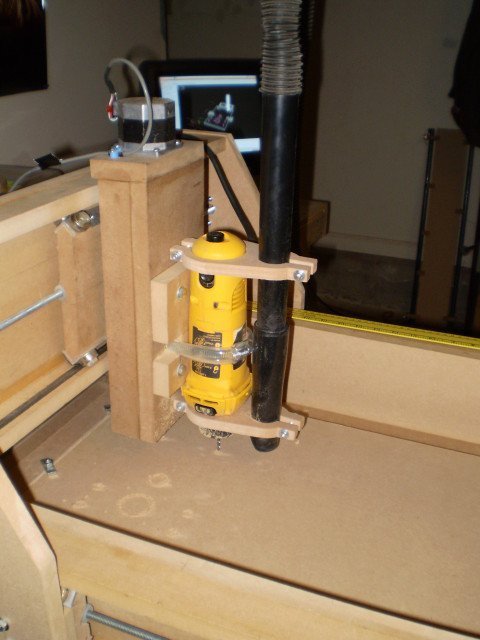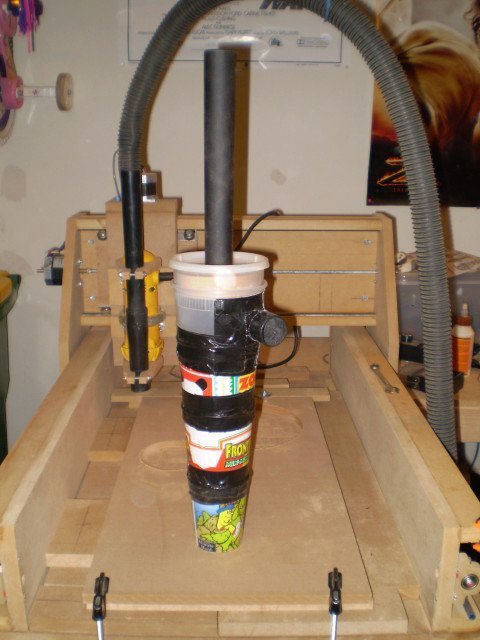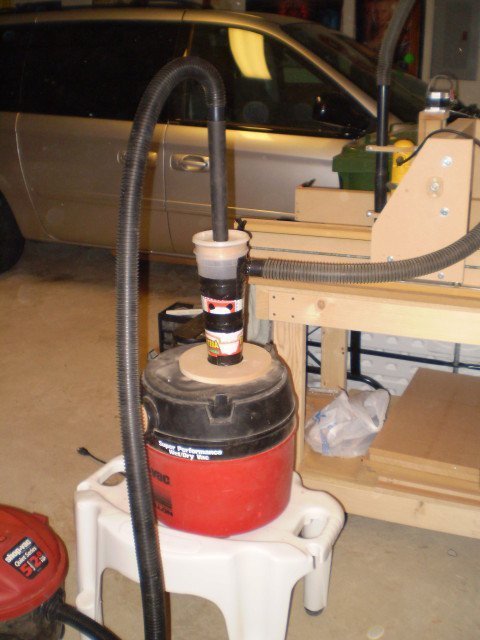Dust control may not the first thing you worry about, but at some point you will. Breathing MDF dust is not good thing, so I built a vacuum mount for the Model D, it does not catch all the dust, but it keeps it out of the air.

Shortly after I hooked it up, my shop vac died. The Administrator over at at Rockcliff Machines Inc. said it was probably the MDF dust clogging the vac filter that killed it (overheating I guess) and pointed me to the Dust Deputy, which looks very nice and reasonably priced. However since I am/was fiscally challenged at the time, and have a serious DIY streak, I decided to see what it would take to make something like it.
Using some take out soup containers, plastic soda cups, duct tape, a circle cut out of MDF, an extension vacuum tube, and 1 screw with bolt and a washer I came up with this:

I recycled the old shop vac to make the dust bucket, the whole project took about 4 hours with about half of that being for the retro-fitting the old shop vac.

Initial testing would seems to indicate is works. The whole project cost me nothing since I had all of this in the house, I would guess if you had to buy duct tape and the vacuum tube you might spend $10 bucks. I have a number of other ideas on how to build something like this, but this works and is dirt cheap.
I went ahead and made a video outlining the building of the cyclonic dust separator:
Here is a link to an article on cyclonic dust separation at wikipedia.
Other cheap alternative is a cyclonic lid for small (or large) vacs. I know Grizzly and other woodworking stores carry them. They snap on 5 gal pails and you just plug your in and out-take hoses to the lid. Instead of using a small pail, use as tall a pail as you can find (or modify some pails to make a tall pail) for optimum dust removal. I use dual garbage barrels on my 5hp dust collector. They remove a lot of dust so my felt bags stay relatively empty.
One other suggestion is to put some hose (stockings) over your dust filter. The hose helps the filter remain unclogged when on and a simple bump of the vac after power off helps the hose shake off the dust. Never have burned up a motor when using this technique.
I’d love to see the efficacy of this on drywall (gypsum board) dust. I know centripetal force affects all particles – but that stuff is so fine…the killer of vacuum motors.
I made one for sucking up the drywall plaster. I bought the hose, pad and sandpaper from the local big box home store.
I used a 5 gallon drywall bucket. Drilled two holes in the top, about a third of the way from the rim. One for the sander and the other for the shop vac hose. I used another drywall bucket cutting the side in a oval shape and cutting the bottom leaving a one inch flange. This part was screwed to the bottom of the lid. The part was cut to fit inside the bucket with a few inches clearance from the sides and bottom. Basically its function was to serve as a deflector to knock the dust to the bottom of the bucket. Warning – one thing that happens when you accelerate small particles at a high velocity, the particles develope a charge. I received an unwelcome shock when I went to pick the bucket by the handle. My fix was to put a screw in the gound of an extension cord and attach the alligator clip to the metal handle.
I built a cyclone lid for a small steel drum and use my ShopVac for suction. It can be seen at http://www.iedu.com/DeSoto/Projects/MiniCyclone/ – I don’t know how well it’d do for drywall dust, but does work well for wood dust.
For drywall sanding dust – I made something very similar to KShimeld’s – but I fill the bucket about 1/3 full of water – I’ve never been electrically shocked by it – and it gets pretty much all the drywall sanding dust trapped into the water.
Pingback: grumpygeek.com » Blog Archive » No, I am not dead.